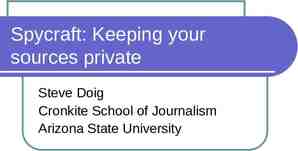Health and Safety in the Laboratory This material was produced under
30 Slides620.50 KB
Health and Safety in the Laboratory This material was produced under grant number SH-17035-08-60-F-11 from the Occupational Safety and Health Administration, U.S. Department of Labor. These materials do not necessarily reflect views or policies of the U.S. Department of Labor, nor does mention of any trade names, commercial products, or organizations imply endorsement by the U.S. Government.
Objectives After this session, you will know: How to identify health and safety hazards of school laboratory work Health and safety measures your lab should have in place How best to protect yourself from hazardous exposures The requirements of OSHA’s Laboratory Standard 2
Laboratories in the News Two dozen fire departments responded yesterday to Rocky Point High School after a science teacher was burned when a chemical reaction in a science lab touched off a small explosion. The teacher, Anthony Nobre, 26, of Medford, suffered burns over his arm, neck and face. He was taken to University Hospital in Stony Brook, where he was listed in satisfactory condition, according to a spokeswoman. The blast erupted as Nobre put crystallized sodium into a container holding a small amount of water. The Brookhaven fire marshal was conducting an investigation and recommended that the building be closed today. Detroit’s Miller Middle School will be closed today and possibly Wednesday while health and environmental officials finish cleaning up a small amount of mercury that students spilled in a science class just before school was dismissed Monday. Students apparently were playing with about an ounce of the toxic substance in a sealed vial when it spilled, said a district spokesman Stan Childress. About 30 students and a teacher were present, he said. There is a possibility that students may have tracked through the mercury because some beads of the substance were found in 3 the hallway, Childress said.
Why All the Fuss? Exposure to Hazardous Chemicals Can Result in acute or chronic health effects Acute – occurring within hours or days of exposure Chronic – occur after exposure over many years 4
Engineering: Removes or Separates Hazard from Person i.e.: Local Ventilation (Fume Hoods) Chemical Substitutions Administrative: Procedures that Limit Contact with Hazard i.e.: Job Rotation School Staff Training Good Housekeeping 5
Personal Protective Equipment (PPE) PPE Should Be Considered Only After Administrative and Engineering Controls Have Been Applied. Minimum Recommended PPE: Chemical Resistant Gloves, Splash Proof Goggles, Lab Coat, Face Shield, and Rubber Apron when Necessary 6
PPE: Glove Selection Should be based upon: the chemical composition of the substance you are working with the properties of the glove material. Find Out More about Glove Selection by Reviewing Material Safety Data Sheets (MSDS) or from Glove Supply Companies. 7
OSHA’s Laboratory Standard Protects staff who use and handle hazardous chemicals in laboratories Requires your School to: – Determine staff exposure to any substances regulated by the standard – Conduct initial training & additional training if a new hazard is introduced into the lab – Develop a Chemical Hygiene Plan 8
Training Requirements Labs are required to suppleme nt course material with sitespecific informatio n& training including: Specific Work Practices Chemical hygiene plan/lab manual Location & availability of MSDSs Specific lab safety work practices or SOPs Training whenever new hazards are used in the lab Personal Protective Equipment Instruction on appropriate PPE & how to use it Location & availability of PPE & maintenance of reusable PPE Lab Equipment Location & operation of eyewash &/or shower stations Use of fume hoods, storage cabinets, refrigerators & other engineering controls Waste Handling and Spill Response Chemical waste handling & disposal procedures Location & availability of spill kits & emergency checklists Spill response procedures 9
Chemical Hygiene Plan Must Include: Designation of a Chemical Hygiene Officer Exposure control measures Measures to ensure properly functioning fume hoods & equipment Staff training on hazard awareness & measures available to protect themselves Provisions for medical consultation & examination Respiratory protection program Recordkeeping procedure Hazard identification system 10
Safe Practice: Maintain a Chemical Inventory! Conduct a yearly inventory of chemicals and update the file of material safety data sheets (MSDS) to prevent the accumulation of orphaned chemicals Some of these chemicals become unstable, react with the container, slowly degrade or evaporate 11
You Have the Right to Know! OSHA’s Hazard Communication Standard requires that ALL Containers Must be Labeled With: Chemica l Name & Physical/ Health Hazards Name & Address of the Manufactur er & Emergency Contact Numbers 100 Main St., Philadelphia, PA 1-800-555-1212 12
Types of Labels NFPA Diamonds and HMIS Bars are Color & Number Coded with Hazard Information DOT Symbols Are Usually Found on Shipping Cartons 13
Material Safety Data Sheets (MSDS) An MSDS Must Be on File & Available for Each Chemical in the Lab. An MSDS lists: – – – – – – – – Product Identity Hazardous Ingredients Physical Data Fire & Explosion Hazard Data Reactivity Data Health Hazard Data Precautions for Safe Handling & Use Control Measures 14
What Should the Ideal Laboratory Look Like? Practices Equipment & Ventilation 15
General Ventilation Supply Air Diffusers & Room Air Exhausts Should be Located So As to Avoid Intake of Contaminated Air Windows Should be Operable 16
Local Ventilation Fume Hoods Used For Operations that Give Off: Noxious Odors Flammable or Poisonous Vapors HOW DOES YOUR VENTILATION MEASURE UP? 17
Safety Showers and Eyewashes Must Be Available in All Lab Areas That Use or Store Chemicals Which Are Corrosive or an Irritant to the Eyes or Skin Combination Eye Wash & Drench Hose Units at the Sink are Now Available 18
Match the Extinguisher to the Risk! Fire Extinguishers Must Be: Clearly labeled to indicate the types of fire they are designed to extinguish. Visibly inspected monthly and maintained annually. Class ABC Extinguishers Should Be Located: –At the Laboratory Exit –Within 50 Feet of Any Point in the Lab. Class D Extinguishers Are Required for Combustible Metals. 19
Means of Egress/Exit Two or more well- marked & unobstructed evacuation exits are recommended in a lab. 20
It’s Shocking! There should be no accessible live, exposed electrical wiring. Consideration should be given to installing ground-fault circuit interrupters on electrical circuits within 6 feet of water sources. Electrical Safety in the High School Lab 21
Chemical Storage Safe Storage of Chemicals is a Necessity in Every School Laboratory! Minimizes Exposure to Students and Staff to Corrosive and Toxic Chemicals Lessens the Risk of Fire Prevents the Mixing of Incompatibles & the Creation of an Emergency Situation 22
The “Don’ts” of Chemical Storage! Avoid storing any chemical above eye level Don’t store incompatible chemicals together Don’t store chemicals near sources of heat or sunlight Don’t store chemicals in the hoods or acids on metal shelves Avoid storing anything on the floor, especially glass bottles 23
Biology Storage 24
So, You’re in Charge! How would you organize and store chemicals in your perfect lab? 25
Ideal Storage Area SetUp NA, LI Acids Room Should Have: Oxidizers Eye Wash Safety Shower Emergency Phone Spill Materials Base s Fire Extinguisher Metal Salts Nitrates Dry Chemical s Flammables Cabinet 26
Be Prepared for Small Incidental Spills Chemical Categories Found in Most Secondary Schools Include: – Organic Solvents – Acids – Alkalis (Bases) – Mercury Proper Incidental Spill Control Equipment Includes: Spill Control Materials Such As Spill Control Pillows, Pads, Booms, etc. Scoops, Brooms, Pails & Bags Absorbent – such as Diatomaceous Earth Neutralizers – for Acids & Alkalis Mercury Spill Control Kit 27
Certain Spills Aren’t for Quick Clean-up As a science teacher or lab specialist, you should only respond to incidental chemical releases, or small spills. For large or especially hazardous spills: – Quickly assess whether there are any injured persons and attend to any person who may have been contaminated. – Follow the notification, evacuation and emergency medical treatment procedures for your school. – Evacuate the immediate area until the hazardous release has been characterized and controlled. 28
Waste Chemical Disposal Requires: – Proper storage– same rules apply – make sure waste chemicals are compatible – Proper labeling – tags should be placed on bottles name of chemical – Pre-planning – know what waste you’re creating prior to carrying out experiments; minimize purchases – Record-keeping – of all waste chemicals on hand and those already picked up for disposal 29
How to Assess Your Classroom for Hazards Using the Checklist Working with Your Union 30



































